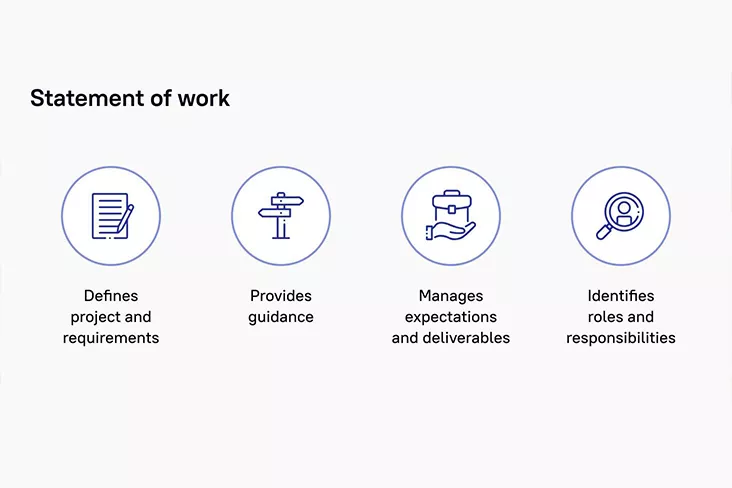
When starting cooperation with any partner, especially a new one, it’s natural to feel a bit worried. Every businessman wants to avoid risks and put every detail plainly and clearly into the contract. Today we are going to speak about software development outsourcing and how to correctly put together a Statement of Work to be protected against the possible risks and challenges that may set in.
Please find below a helpful guide that will give you all the information you need to know about what's SOW, what goes into one, and how to create an effective document that will get everyone on the same wavelength. Let’s dive deeper into this topic.
What's Statement of Work (SOW) in Software Development
So, what does SOW stand for? The meaning behind this abbreviation is Statement of Work. It is a document used in project management that establishes the scope, objectives, and deliverables for a project. It typically includes a detailed description of the work to be done, as well as the schedule, budget, and other important project-related information.
The Statement of Work should be created and agreed to by both the customer and the development company before any work begins. This document ensures that everyone is concordant with the terms, knows what is expected, and has a clear understanding of what will be delivered at the project's end.
Want a web app that does more?
Let's build a solution that's smart, sleek, and powerful.
Alina
Client Manager

Importance of SOW in the Software Development Process
A statement of Work is essential as it sets expectations for the project and establishes accountability. Without it, it can be difficult to determine whether the project is on track or not.
While the SOW is often seen as a dry and boring document, it is actually a critical part of any software development project. A well-defined SOW helps to scope the project, to set reasonable timelines, and allocate resources.

The SOW is also important since it sets expectations for both the client and the contractor. By defining the scope of work, deliverables, schedule, and quality standards upfront, both parties can avoid misunderstandings and disagreements later on in the project.
Thus, it is critical that the SOW be well-written and carefully reviewed by both the client and contractor before the project work begins.
Now, as we already know the statement of work definition, let’s move on to some specific writing tips. After all, this is the document that outlines all the aspects of your project and paves the way to success. So, check out the guide we’ve prepared below.
How to Write a Statement of Work for Software Development
Writing SOW may seem daunting, but it doesn't have to be. By following a few simple tips on how to write a statement of work, you can create a clear and concise document that will set your project up for success.
What has to be done: explanation
To write a good SOW, you need to provide a clear explanation of the work that needs to be done. This includes a detailed description of the goals, objectives, and deliverables for the project. A good rule of thumb is to include enough detail to give the reader a clear understanding of the project, without overwhelming them.
Of course, you can search for some SOW templates on the Internet, but be sure to tailor it to your specific project. Your own view and understanding of the project will be much clearer than someone else's, so it is worth taking the time to write your own.
What else should we clarify before starting?
Keep in mind that you should include some other relevant information that would be helpful for the development team. This could include the following:
- Project timeline,
- Acceptance criteria,
- Resource requirements,
- The list of technologies to be used,
- Risks and constraints,
- Communication plan,
- Reporting requirements,
- Settlement of the standards,
- Budgeting and financial details.

Let's talk more about each point in turn.
Project timeline: Make sure to include a clear and concise project timeline in your SOW. This will help the development team understand the work that needs to be done and how much time they have to complete it. Thus, your statement of work for software implementation should always refer to the project timeline.
Acceptance criteria: It is also important to include acceptance criteria in your SOW for software development. This will help ensure that the final product meets your expectations. The acceptance criteria should be specific and measurable. For example, you might include a requirement that the software will be capable to handle a certain number of users or transactions.
Resource requirements: The resources that will be required to complete the work, including labor, materials, and equipment, should also be included in the SOW. This could include the number of developers needed, the type of expertise required, and any other relevant information.
Technologies: To ensure that the contractor can meet your needs, you should also include a list of technologies that they will need to use. This could include programming languages, database systems, and application servers.
Risks and constraints: When writing a SOW, it is also important to identify any risks and assumptions that may impact the project. This could include budget, time, or resource constraints. Thus, the development team can understand your project better and mitigate any risks.
Communication plan: There might be some cultural misunderstandings such as habits, slang, unfamiliar abbreviations, or even tone of voice. So it is important to be clear about communication channels, formats, and tools from the outset.
- The communication plan should include the following:
- Who will be responsible for communication?
- How will communication often take place?
- What format will communication take? (e.g., email, phone, in-person meeting, etc.)
- What information will be communicated?
Reporting requirements: In order to track the progress of the project, you should also include reporting requirements in your SOW. The development team should know how often they need to report back to you, and what information needs to be included in those reports. This could include daily reports, weekly reports, or monthly ones.
Settlement of the standards: It is also essential to agree on the standards that will be used for the project. This could include coding standards, testing standards, or documentation standards. Make sure to include the information on who will be responsible for settling any standards disputes that may arise.
Budgeting and financial details: This will help the software development team to understand the cost of the project and what kind of financial constraints they need to be aware of. It is important to make sure that the project is within your budget.
Where has it to be done?
Due to the cheaper talent pool, the outsourcing vendor often develops the product overseas from the client’s country of origin. However, this may lead to difficulties in communication due to time zone differences that may impact project deadlines. For this reason, it is important to be specific about where the work will be done and to make sure that there is a clear understanding of the time zone differences. All in-personal meetings should be discussed in advance.
How precisely has it to be done?
There is no one-size-fits-all answer to this question, as the specific procedure for writing a Statement of Work for software development will vary depending on the project in question and the specific requirements of the client. However, the SOW process generally includes the following steps:
1. Define the project scope and objectives.
2. Develop a preliminary schedule.
3. Create a work breakdown structure (WBS).
4. Determine deliverables.
5. Prepare a cost estimation.
6. Identify the possible project risks.
7. Create a communication plan.
8. Finalize the SOW document.
It is understandable that the SOW document should be clear, concise, and easy to understand. It should also be specific enough to provide guidance to the software development team, but flexible enough to allow for some changes and adjustments during the course of the project. In short, the SOW should strike a balance between being too rigid and too vague.
How exact should the deadlines definition be?
The deadlines should be specified in the software Statement of Work to ensure that the project stays on track. In addition, the SOW should include a provision for milestones, which are specific points in the project timeline at which certain tasks need to be completed. Milestones help to keep the project on schedule and provide checkpoints for measuring progress.
Who should control the process of SOW execution?
As the SOW document is a contract between the client and the vendor, it is important that both parties agree on who will be responsible for its execution. In most cases, the project manager should be responsible for overseeing the SOW process and ensuring that all deliverables are met.
What should the goals achievement definition be like?
The SOW should also include a section on how the success of the project will be measured. This could include defining specific metrics or KPIs (key performance indicators) that need to be met for the project to be considered a success.
This will help to ensure that both the client and the vendor are clear on what is expected from the project, and can agree on a mutually-acceptable definition of success.
How payment process should be arranged?
This is probably the most important section in SOW for many businesses. This is where you'll state how much a client should pay when a payment is due, and what deliverables are to be provided for payment to be released.
It's important to be as specific as possible in this section to avoid any misunderstandings or disputes down the road. For example, instead of simply stating "payment will be made upon completion of the project", you can say "payment will be made within 7 days of delivery of all project files and final approval from the client".

Typical Mistakes in Statement of Work for Software Development
When it comes to drafting a statement of work in software development, there are a few major mistakes you'll want to avoid. Here are some of the most common pitfalls:
1. Not defining the project’s objectives upfront. Companies should take the time to define the objectives of the project in the SOW. These objectives should be specific, measurable, achievable, relevant, and time-bound (SMART approach to goal setting). Without a clear understanding of what you want to achieve with the project, it will be difficult to set realistic expectations and scope out the work required to meet those objectives.
2. Being too specific (or not specific enough). It's important to strike a balance here and provide enough detail so that your software development team knows what you're looking for, but not so much that you limit their creativity or bind them to a certain outcome.
3. Failing to account for the change. In any software development project, there will inevitably be some changes along the way. Make sure your SOW includes provisions for making changes and outlines how those changes will be managed and paid for.
4. Failing to adequately scope the project. This can lead to some problems down the road, including scope creep, budget overruns, and missed deadlines. Make sure you take the time to properly scope out your project before you get started. Also, don’t confuse two definitions – statement of work and scope of work. The latter is only part of SOW.
5. Failing to establish clear communication channels. If you're not communicating effectively with your software development team, it's going to be very difficult to get the results you're looking for. Bad communication is often a recipe for disaster.
6. Placing program cost ahead of program quality. It's tempting to try to save money by skimping on the development process, but this is often a false economy. When program quality suffers, so does the overall value of the software to the customer. In many cases, it’s more expensive to fix poor-quality software later than it is to do it right the first time.
Who Writes the Statement of Work
The answer to this question depends on the size and complexity of the project. For small projects, the SOW in software development may be prepared by the project manager or a designated member of the project team. For larger projects, it may be written by a team of experts or an SOW development manager.
Regardless of who prepares the scope of work, it is important that all parties have a clear understanding of what is included in it before the project begins.
Now you are familiar with the SOW abbreviation. In this FAQ section, we'll address some common questions and provide clear explanations to help you grasp the importance of SOW software projects.
FAQs
What is the primary purpose of a Statement of Work in software development projects?
The main purpose of the statement of work software is to clearly define the scope, responsibilities, and expectations for a software development project. It acts as a contract between the client and the development team, ensuring that everyone is on the same page from the start. Adhering strictly to the sow contract meaning helps maintain transparency and accountability throughout the project lifecycle.
What are the essential components that should be included in a well-crafted SOW?
A typical software sow example starts with an overview of the project and its goals and scope of work for software development. It is followed by a detailed description of the specific tasks, features, and functionalities to be developed. The SOW also outlines the tangible products or services to be delivered. These are the software itself, documentation, or training materials. Additionally, it establishes a realistic project timeline with specific milestones and deadlines. It also assigns roles and responsibilities and defines the criteria for determining when the work is complete and acceptable. Finally, the SOW addresses the payment terms, invoicing procedures, and any applicable fees or penalties.
Who is typically responsible for drafting and finalizing the SOW in a software development project?
The responsibility of drafting the initial sow contract usually falls on the client or the project manager. However, it is a collaborative effort, and both parties (client and development team) should review and provide input to the sow meaning everybody shares mutual understanding and expectations.
Conclusion
All in all, SOW is an acronym that stands for Statement of Work. It is an important document in any software development project. By clearly outlining the scope of work, terms and conditions, and schedule, ensures that both parties are on the same page from the very beginning. This not only saves time and frustration later on but also helps avoid scope creep and other issues.
At Stfalcon, we are always very careful with Statements of work prepared and agreed on with our clients. That’s why we have so many high-profile foreign customers satisfied with our work and high rating on Clutch, for instance. We always have clear-cut requirements, and it helps us to meet them even the most strict project needs.
Hope this article has helped you to feel more prepared to tackle your next project. We are always ready to discuss it in person, so feel free to contact our expert, right now.
About the Author
Vitalii is a Project Manager with extensive knowledge and experience in fields that matter for a project's success. He has a proven track record in coordinating a number of large-scale projects from idea to deployment. Currently, he is working with the Stfalcon team.



